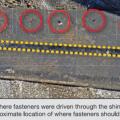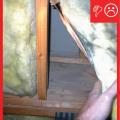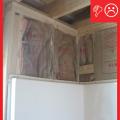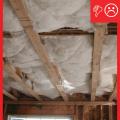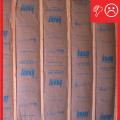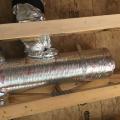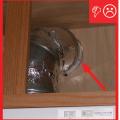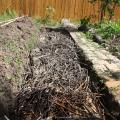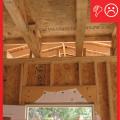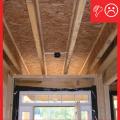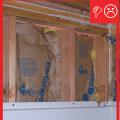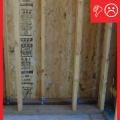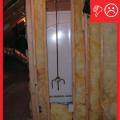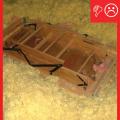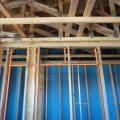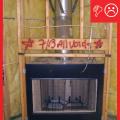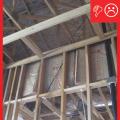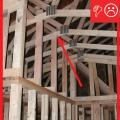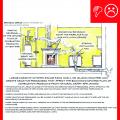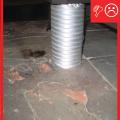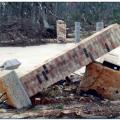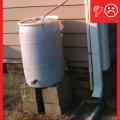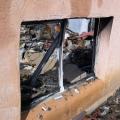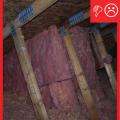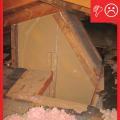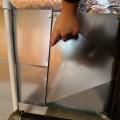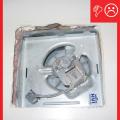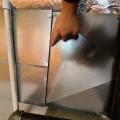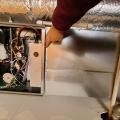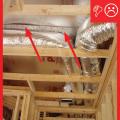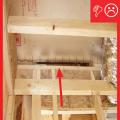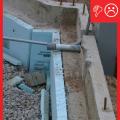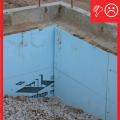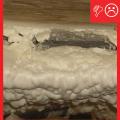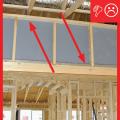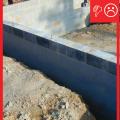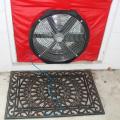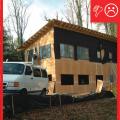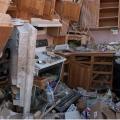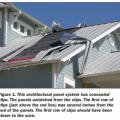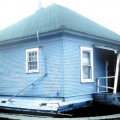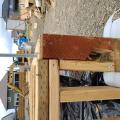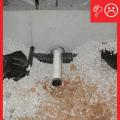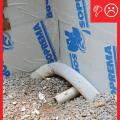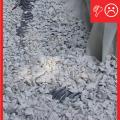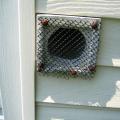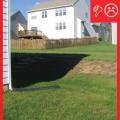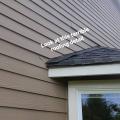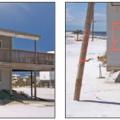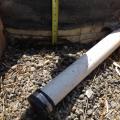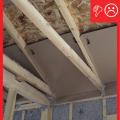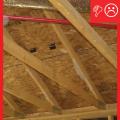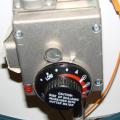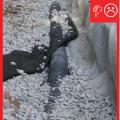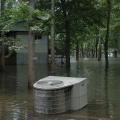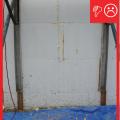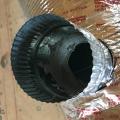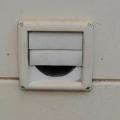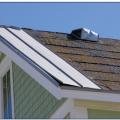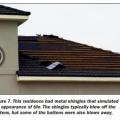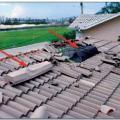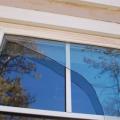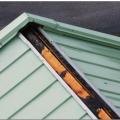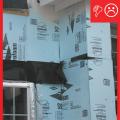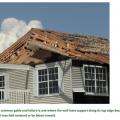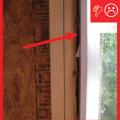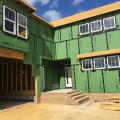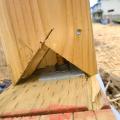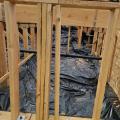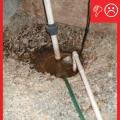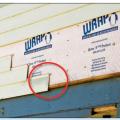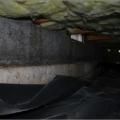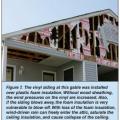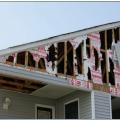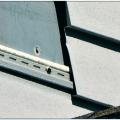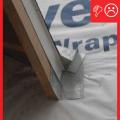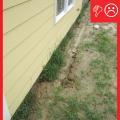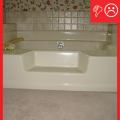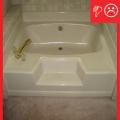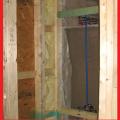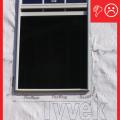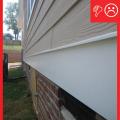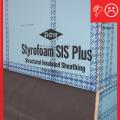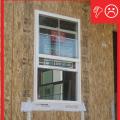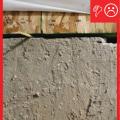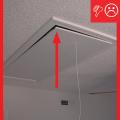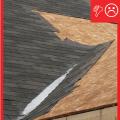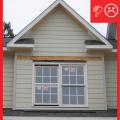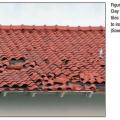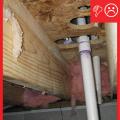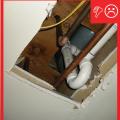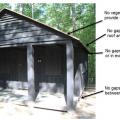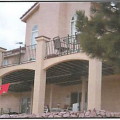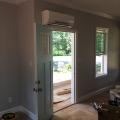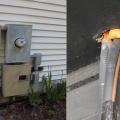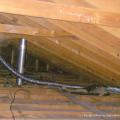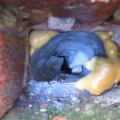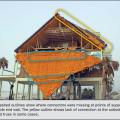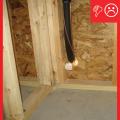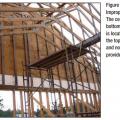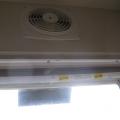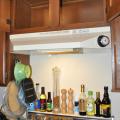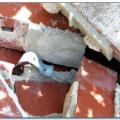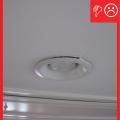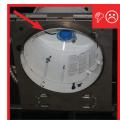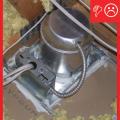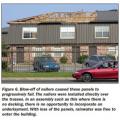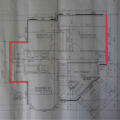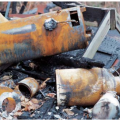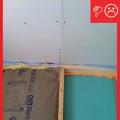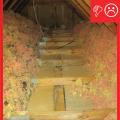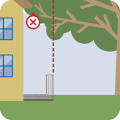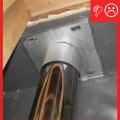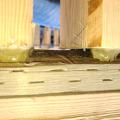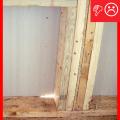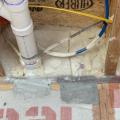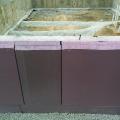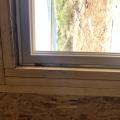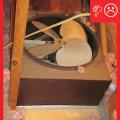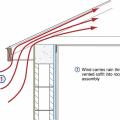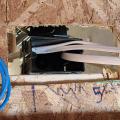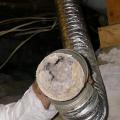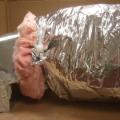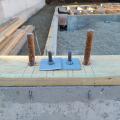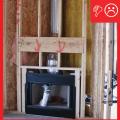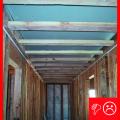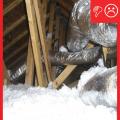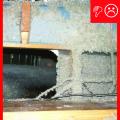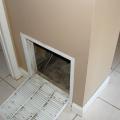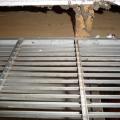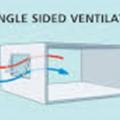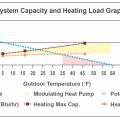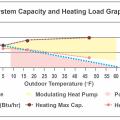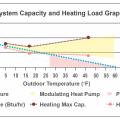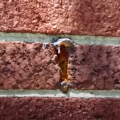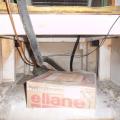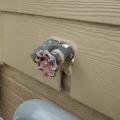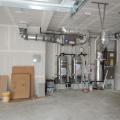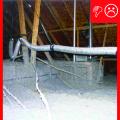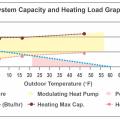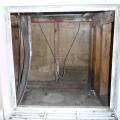Showing results 4751 - 4973 of 4973
Wrong – Insulation does not fill entire cavity nor is there an air barrier present between the double wall
Wrong – Insulation is in direct contact with this non-insulation contact (IC)-rated recessed light fixture
Wrong – Insulation should not be pinched where flex ducts connect to the trunk duct as compression of the insulation here can lead to cold spots and condensation on the duct surface.
Wrong – It is difficult to test the air flow in this fresh air intake duct due to poor access and inadequate length of straight duct to get an accurate in-line flow measurement.
Wrong – It is not good practice to route plumbing through sill plates or on an exterior wall.
Wrong – Known as a Hugel Swale, organic matter like sticks and leaves break down into compost and fill the swale full. This limits the swale’s ability to filter rainwater.
Wrong – Misalignment of the tie reduces the embedment and enables the brick veneer to be pulled away.
Wrong – No air barrier installed between the walls and a larger gap between the walls that needs sealing
Wrong – No blocking installed to prevent attic insulation from falling into stairs and opening
Wrong – No membrane or sealant is installed to air seal at the roof-truss assembly junction with the party walls
Wrong – No polyethylene sheeting vapor barrier is installed on the crawlspace floor
Wrong – Overly powerful kitchen exhaust fans can backdraft other combustion appliances in the home
Wrong – Piers set on individual footings with inadequate anchoring to the ground were twisted and toppled by a coastal storm surge, while those anchored in the concrete pad stayed upright.
Wrong – Polyethylene sheeting does not completely cover the aggregate and the footing
Wrong – Polyethylene sheeting does not extend beyond edge of aggregate to separate the footer from the stem wall which will be poured next
Wrong – Rain barrel installed without an overflow spout that terminates away from foundation
Wrong – Regular window glass is susceptible to breakage from the radiant heat of a wildfire; tempered and laminated glass are more resistant to breakage.
Wrong – Rips in foil air barrier behind shower were not taped; solid air barrier material is more durable.
Wrong – Roof underlayment is not fully adhered and roof deck seams are not sealed so roof is susceptible to high-wind events
Wrong – Roughly cut hole that is larger than the fan, making it difficult to seal
Wrong – Roughly cut hole that is larger than the fan, making it difficult to seal
Wrong – Seams in the furnace-to-AC connection at the air handler are not sealed.
Wrong – The asphalt shingle shim is too small and the floor joist was cut too short.
Wrong – The backing on this knee wall was not air sealed prior to adding insulation.
Wrong – The batt insulation on this knee wall is not properly supported and there is no air sealed rigid backing to provide a solid air barrier.
Wrong – The blower door is installed improperly with a gap at the corner and along the side of the frame that will allow air leakage and could allow the frame apparatus to become dislodged during testing
Wrong – The blower door pressure reference hose (blue) ends too close to the outdoors side of the fan. Air moving across the end of the hose will affect the pressure reading
Wrong – The cabinets and drawers were not outfitted properly with mechanical or self-locking latches, causing them to swing open and spill their contents onto the floor.
Wrong – The clips holding these metal roofing panels were set too far from the roof eave (above red line) and the panels lifted in strong winds
Wrong – The corners are not properly flashed, leaving a vulnerable area in the drainage system
Wrong – The damaged rim joist was not replaced and its strength is compromised in a critical load-bearing corner.
Wrong – The drain tile is cut and now does not extend around the entire foundation footing
Wrong – The drain tile is not installed to terminate properly and will not transport water to the exterior
Wrong – The drain tile is not wrapped in fabric and could become clogged with debris
Wrong – The duct for this kitchen exhaust fan is made of flex duct instead of smooth metal duct and the duct is not properly supported.
Wrong – the exhaust terminal for a clothes dryer should not be covered with a screen which could trap lint; instead, cover it with a hooded, louvered damper
Wrong – The flashing of the roof-wall juncture was installed above the roof shingles instead of below the roof shingles; also no kickout flashing was installed.
Wrong – The flashing tape was not installed with a roller to completely adhere it to the OSB sheathing surface.
Wrong – The footers of this house were not deeper than the depth of scour during a flood, causing undermining of the foundation
Wrong – The footing drain pipe should end at least 10 feet from the foundation if above ground or should drain into a drywell or storm sewer.
Wrong – The framing and wind baffle installation will not allow for required insulation depth.
Wrong – The gable end wall failed because the rigid foam sheathing was not backed up by plywood or OSB.
Wrong – The gas water heater is left on during enclosure leakage testing, which could result in dangerous backdrafting of the water heater when the home is depressurized
Wrong – The gravel surrounding the drain tile is too large and will let too much debris through
Wrong – The house was not bolted to the foundation and shifted off the foundation during an earthquake.
Wrong – The HVAC compressor was not adequately secured to an elevated platform and was washed away.
Wrong – The insulated concrete forms at the foundation do not have a damp-proof coating
Wrong – the interior seam of the branch duct to trunk duct juncture is sealed with mastic but there are gaps around the exterior seam that should also be sealed with mastic or metal tape.
Wrong – The kitchen exhaust fan duct is attached to flex duct, which is prohibited by code.
Wrong – The lower flap on this dryer vent opening is missing, allowing rodents access.
Wrong – The metal panels covering this roof used snaplocks and concealed fasteners that gave way in high winds.
Wrong – The off-ridge roof vent on the right was poorly anchored and pulled off in high winds allowing water into the home.
Wrong – The open overhang with exposed timbers and unscreened vent holes make this roof more susceptible to ignition.
Wrong – The outer pane of this window broke under radiant exposure from a neighbor’s house that had ignited in a 2007 southern California wildfire.
Wrong – The polyethylene sheeting vapor barrier is not attached to the piers with mechanical fasteners
Wrong – The position of this exhaust fan does not allow the duct to route directly outside in as straight a path as possible.
Wrong – The ridge flashing fasteners were placed too far apart and came loose in high winds.
Wrong – The ridge flashing fasteners were placed too far apart and came loose in high winds.
Wrong – The ridge flashing fasteners were placed too far apart and did not adequately hold the flashing in place
Wrong – The rigid air barrier material between the cantilever and the conditioned space is not air sealed at the seams.
Wrong – The rigid sheathing seams are not taped and the gaps could cause moisture problems
Wrong – The roof sheathing was inadequately fastened and gave way causing the gable end wall to fail
Wrong – the sheathing tape is properly installed to cover all seams in the coated sheathing but the flexible sill flashing product is not consistently installed or fully adhered around the window sills and is missing or lapped at some corners.
Wrong – The south side of this building in Arizona has very little architectural or landscape shading to block solar heat gain.
Wrong – The stud should not be positioned over seismic bolts then cut away, which reduces the stud’s load capacity; Shift the stud or specify stud and bolt positions in plans.
Wrong – The underside of the first course of siding extends beyond the underlying sheathing leaving it vulnerable being pulled off by pressure from high winds.
Wrong – The vapor barrier is not secured to the walls of this crawlspace.
Wrong – The vinyl siding at this gable was installed over plastic foam insulation
Wrong – The vinyl siding at this gable was installed over rigid foam instead of wood sheathing and neither had the structural strength to resist hurricane wind pressures.
Wrong – the water-resistant barrier is layered underneath the step flashing, which could allow water to get behind the step flashing and into the wall.
Wrong – The water-resistant barrier is not complete and the holes and gaps could cause moisture problems
Wrong – There are no gutters installed and there is not a proper gravel bed located at the foundation
Wrong – There is carpet installed too close to the plumbing fixtures in the bathroom
Wrong – There is carpet installed too close to the plumbing fixtures in the bathroom
Wrong – There is no flashing installed at the bottom of the exterior walls to create a drainage system
Wrong – There is no flashing installed at the bottom of the exterior walls to create a drainage system
Wrong – There is no foam gasket or air-sealing between the sill plate and masonry foundation.
Wrong – There is not a self-sealing bituminous membrane installed at the valley of the roof
Wrong – There is not a water-resistant barrier installed underneath the exterior finish of the walls
Wrong – There is visible light around the door because no weather stripping has been installed.
Wrong – These clay roof tiles were dislodged by high winds due to inadequate anchorage.
Wrong – These flex ducts are pulled taut, which is correct but they are inadequately supported with straps that are spaced too far apart and are too tight causing pinching of the insulation and turns are sharp rather than gradual.
Wrong – These four ties were never embedded into the mortar joint, allowing the brick wall to be pulled away from the sheathing.
Wrong – These holes have been cut larger than needed, making them difficult to seal.
Wrong – These plumbing penetrations have been cut larger than needed, making them difficult to seal.
Wrong – This brick veneer failed in high winds (107 mph) because the ties pulled out of the substrate.
Wrong – This cabin has a gap between the concrete slab and the wall where rodents can enter
Wrong – This deck is constructed with metal railings and the wooden supports are covered with fire-resistant stucco; however, the exposed wooden beams on the underside of the deck still pose a significant fire hazard.
Wrong – This ductless mini-split heat pump was installed above an exterior door allowing conditioned air to escape when the door is opened, heat transfer through the door, and temperature fluctuations that could impact the unit’s thermostat.
Wrong – This electric wiring hole was filled with foam that is not protected with copper mesh or hardware cloth so rodents could chew through the foam and enter the house (see Solution Center Guide "Reduce Pest Intrusion").
Wrong – This exhaust duct extends far beyond what is needed to reach the roof; a short, straight, smooth rigid metal duct is best for exhaust ducts and exhausting to the soffit vent would be preferable.
Wrong – This exhaust fan duct is wrong on several counts: it uses flex duct rather than smooth round metal duct as required by the IRC, the duct terminates inside of the wall assembly instead of outside, the opening is not large enough...
Wrong – this framing material has a moisture content above 18% as shown by the moisture meter
Wrong – This gable end wall failed because connectors were missing at points of support (blue circles) and the outlookers were not connected to the end truss (yellow circle)
Wrong – This house under construction is lacking wall to truss bracing and the bottom chord of the scissor trusses is several feet above the top of the end wall top plate
Wrong – This house was built on a shallow foundation instead of piers; the foundation was undermined by erosion from Hurricane Irma (Vilano Beach, FL)
Wrong – This kitchen exhaust fan is not located directly above the stove top so it will be ineffective at removing cooking pollutants and it terminates within 3 feet of an operable window, which is prohibited by code.
Wrong – This kitchen exhaust is a recirculating model; kitchens should use exhaust fans that duct out through the roof to remove moisture and odors from the home
Wrong – This metal duct is crushed, is sealed with duct tape instead of mastic or UL-181 metal tape, and is not correctly supported.
Wrong – This metal tie remained embedded in the mortar joint but the smooth-shank nail pulled out from the stud.
Wrong – This multi family building appears to be done in traditional southwest architecture but the lack of useful overhangs, dark colored walls, and lack of tinting on windows will result in significant solar heat gain.
Wrong – This roof has no sheathing, when the metal panels blew off there was no secondary protection
Wrong – This roof membrane on a low slope roof is fluttering and may fail because it is not fully adhered and deck seams below are not sealed, allowing air to leak up into the assembly while the membrane is pulled up due to negative pressures from wind
Wrong – This second-story floor plan has red lines that indicate openings from the attic into the interstitial floor space
Wrong – This standard air vent has become blocked by flood debris and is located at the top of the foundation wall; it should not be used as a flood vent
Wrong – This vented crawlspace has standing water because steps were not taken to address site conditions that led to bulk water flow into the crawlspace
Wrong – This water heater was not braced; it fell during an earthquake and ruptured the gas line causing a house fire.
Wrong – Tree branches close to the house are prone to spreading crown fires to the house; the tree should be trimmed so that branches are at least 10 feet back from the red dashed line indicating the deck railing of the house.
Wrong – Two combustion appliances are sharing a flue which could lead to backdrafting if one appliance is updated to a direct vent appliance and disconnected from shared chimney.
Wrong – When insulated sheathing is installed correctly, you should not see daylight. Nail holes were also left unplugged.
Wrong – When insulating with spray foam, care should be taken to completely fill areas around piping and other penetrations to avoid leaving air gaps.
Wrong – When more than one layer of insulation is installed, the seams should be staggered to discourage ground water from reaching the foundation wall.
Wrong – Where possible, design walls and specify window sizes and placement to minimize the use of studs around windows; and seal all wood-to-wood seams to minimize air leakage through walls.
Wrong – Whole house fan installed with holes in surrounding platform that need to be air sealed
Wrong – Wind-driven rain and wildfire embers can enter an attic through the soffit vents.
Wrong – Window not protected and failed due to windborne debris in hurricane force winds.
Wrong –Best practice solid air barrier material was not used behind the shower surround.
Wrong –Excessive length and a vertical angle on this dryer duct reduced air flow allowing the dryer duct to become completely clogged with dryer lint
Wrong –The gate that was attached to the garage at the corner ignited and led the fire to the home, causing the damage seen here.
Wrong- A tie strap should not be used over the duct outer liner because it can compress the insulation. Tuck in the fibrous insulation and seal the outer liner to the connecting duct with mastic or foil tape (Steven Winter Associates 2013).
Wrong-The home was pulled off its masonry pier foundation during a coastal flood due to inadequate pier-to-beam connections.
Wrong-These masonry pier foundations were twisted and displaced by coastal storm surges in Long Beach, Mississippi.
Wrong: Closed-cell spray foam roof insulation was not thick enough to meet IRC levels so the foam surface is colder than the dew point of the interior air and condensation formed on surface of the foam
Wrong: Drywall does not extend beyond chase wall framing and is unsealed in a hallway dropped ceiling chase
Wrong: Drywall does not extend beyond the top plate of the interior walls. This installation has the potential for leakage at the sides where the ducts penetrate the side walls of the chase
Wrong: Ducts are held above the ceiling plane with strapping to provide a good angle into top-entry boots. Once the ceiling insulation is added, this duct will protrude from the ceiling insulation and will not be buried
Wrong: Ducts are held from the rafters with strapping and a large beam prevents ducts from properly lying on the ceiling plane
Wrong: Ducts are not laid across the lower truss cords or ceiling, but are hung from the rafters by straps. As a result, ductwork is not buried
Wrong: Ductwork is not fully encapsulated with ccSPF insulation. The duct jacket is still fully visible at sections of the duct
Wrong: Electrical components were installed near ground level and are likely to be flood damaged.
Wrong: HPWH inlet and outlet are piped to mixing valve inlet and DCW make up, driving erratic HPWH and mixing valve behavior
Wrong: Not enough space was left in the floorplans for both the heat pump water heater and a duct elbow to be attached to the right side of the water heater (the orange circle outlines the tank; the rectangle shows the space needed for the duct)
Wrong: Open wall cavities in the un-air-sealed return plenum connect the plenum to attic spaces
Wrong: open wall cavity connected to this return air plenum is allowing cellulose attic insulation to be pulled into the furnace
Wrong: Single sided ventilation without at least two windows, wing walls, and predictable wind directions is ineffective for generating wind-driven crossflow.
Wrong: Sized per Approach 1 or 2, this heat pump’s modulating zone has a small overlap with the home’s heating load line, resulting in a large amount of short-cycling; the unit will require backup heat when the temperature is below 25°F
Wrong: Sized per Approach 3, there is minimal overlap between this heat pump’s modulating zone and the home’s heating load line, causing excessive short-cycling; it will require backup heat and may not contribute significantly at temperatures below 5°F
Wrong: Sized per Approach 3, there is small overlap between this heat pump’s modulating zone and the home’s heating load line, resulting in excessive short-cycling; it will require backup heat when the temperature is below 5°F
Wrong: The door and filter were removed, allowing unfiltered air to enter the air handler leading to premature failure of the system due to dirt accumulation.
Wrong: The exhaust air from one heat pump water heater is blowing into the intake of the heat pump water heater next to it
Wrong: The fiber-cement siding has cracked due to over-driven nails located too close to the edge of the board; these cracks provide a pathway for bulk water entry and offer little resistance to high winds.
Wrong: The homeowner mistakenly filled in the weep holes in this brick wall with spray foam, preventing drainage from behind the wall
Wrong: The return plenum is not air sealed to separate it from the wall cavities and it should not be used for storage
Wrong: The waterproofing around this hose bib was haphazardly detailed allowing water a pathway to wick behind the siding.
Wrong: This air handling equipment is installed in the garage without isolating the equipment from the garage space
Wrong: This exhaust fan duct is too long and terminates in the attic instead of going through the roof and it is improperly supported; it needs straps all along its length to prevent sagging.
Wrong: This heat pump is oversized even for Approach 4, and its modulating zone has a small overlap with the home’s heating load line, resulting in a large amount of short-cycling.
Wrong: This return air plenum is not lined and air sealed
Wrong: This wall cavity is open to the attic allowing unconditioned, attic air to enter the HVAC system, bypassing the filter, and degrading system life and performance
Z flashing is installed behind the rigid foam and metal lathe that goes behind the stucco siding to protect the transition between the wall sheathing and the exterior foundation insulation.
Zero Net Now built this custom for buyer home in the cold climate in New Paltz, NY, and certified it to DOE Zero Energy Ready Home specifications in 2021.
Zero Net Now built this custom for buyer home in the cold climate in Wallkill, NY, and certified it to DOE Zero Energy Ready Home specifications in 2020.
